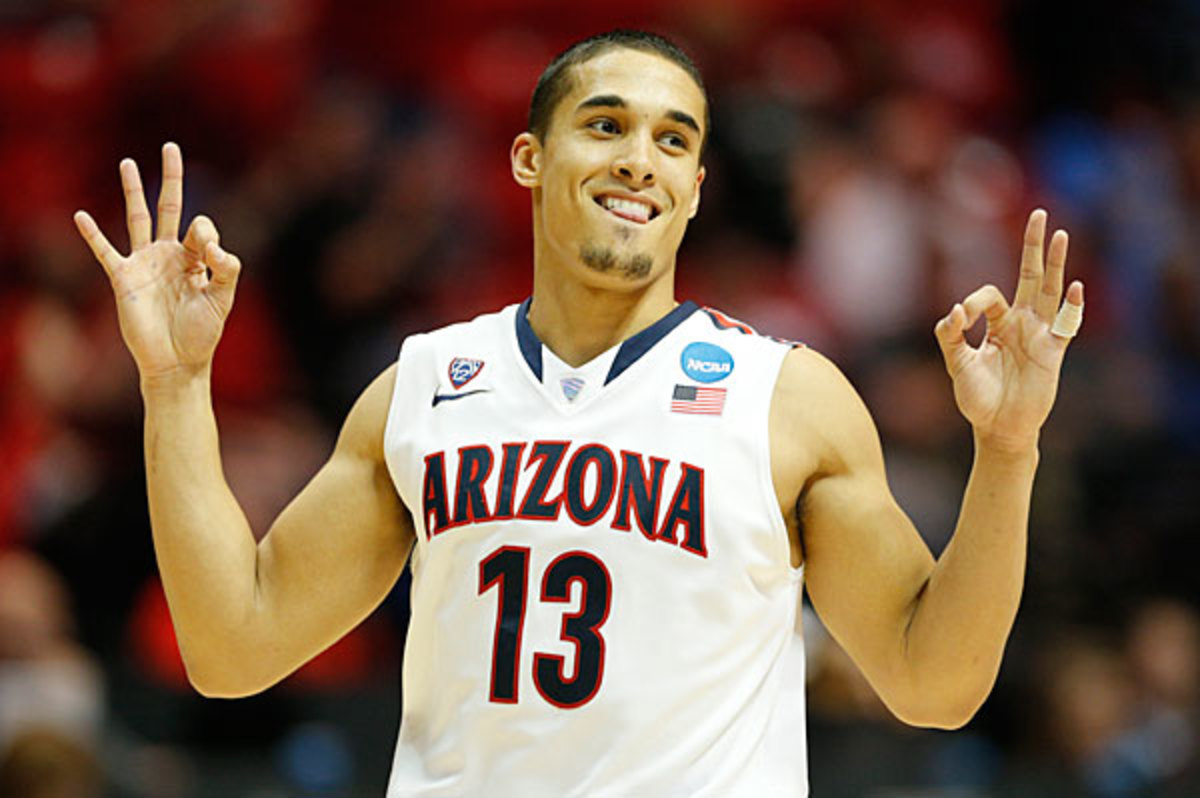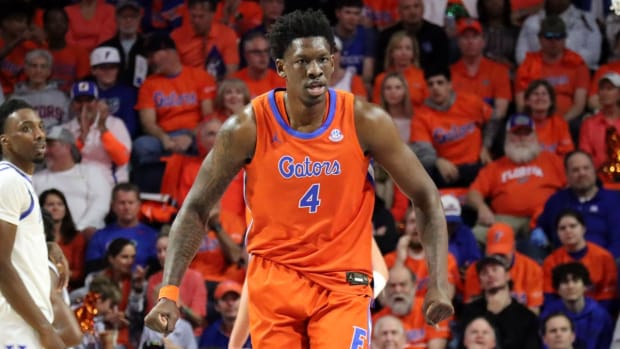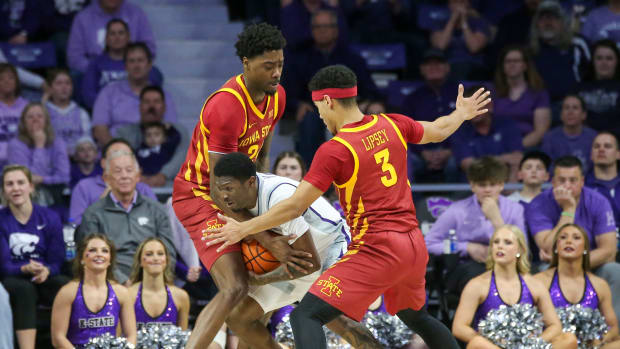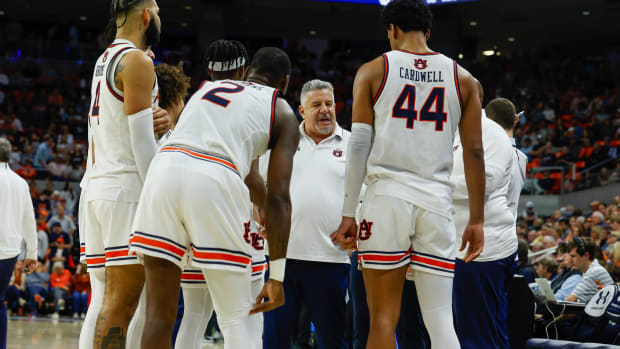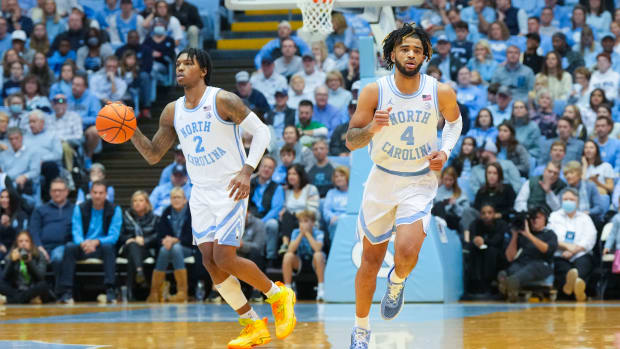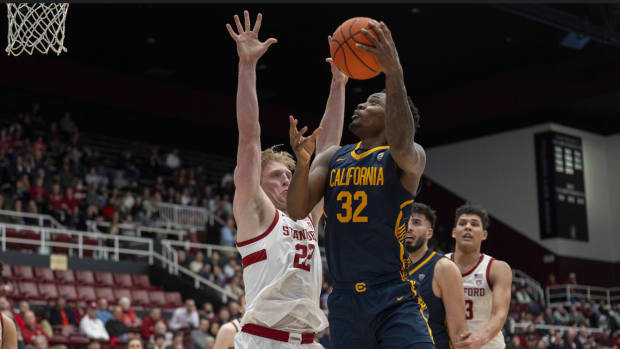Resetting the West region: Arizona, San Diego State, Baylor and Wisconsin
NIck Johnson has helped the Wildcats to their second straight Sweet 16 appearance. (Ric Tapia/Icon SMI)
You may not have watched every game of the NCAA tournament, but don’t worry: We did. We’ll tell you how each team got to the Sweet 16 and why they will or won’t make the Final Four.
Dates: Thursday, Saturday
Location: Honda Center, Anaheim, Calif.
Sweet 16: No. 2 Wisconsin vs. No. 6 Baylor, 7:47 p.m. ET, TBS; No. 1 Arizona vs. No. 4 San Diego State, 10:17 p.m. ET, TBS
Elite 8: TBD
Other regional resets:East (Virginia vs. Michigan State; Iowa State vs. Connecticut) | Midwest (Michigan vs. Tennessee; Louisville vs. Kentucky) | South (Florida vs. UCLA; Stanford vs. Dayton)
Arizona Wildcats
How they got here:
Arizona got more of a challenge than expected from No. 16 Weber State but won 68-59 in the second round, then asserted its dominance over No. 8 seed Gonzaga with an 84-61 blowout in the third round.
Why they’ll make the Final Four:
In short, defense. Arizona is Ken Pomeroy’s top-ranked team in adjusted defensive efficiency, and it has allowed 61 or fewer points in five of its last six contests. In the Wildcats’ win over Gonzaga, Arizona turned 21 Bulldogs turnovers into 31 points, and it finished the regular season with the Pac-12’s best rebounding offense (38.4). That complete package helped the Wildcats manage 31 victories this year against a top-five strength of schedule. Coach Sean Miller’s crew faces San Diego State in the Sweet 16, but the 'Cats have already beaten the Aztecs once this season. That’s a good start to Arizona’s Final Four path.
Why they won’t make the Final Four:
After a 28-2 start, the Wildcats lost two of their last four games to close the regular season. One of those losses came against UCLA, a No. 4 seed in this tournament. And if games turn into tight free throw contests, it’s a good idea not to bet the house on Arizona. The Wildcats hit only 65.5 percent of their shots from the charity stripe, while their opponents knocked down 71 percent. But it might not come to free throws if Arizona gets past San Diego State, where one of two efficient offenses in Wisconsin or Baylor will be waiting to give the Wildcats’ vaunted defense a true challenge.
- By Zac Ellis
Can Xavier Thames and San Diego State shoot well enough to survive the weekend? (Young Kwak/AP)
San Diego State Aztecs
How they got here:
The Aztecs barely survived a second-round challenge from No. 13 New Mexico State, winning 73-69 in overtime. They breezed past North Dakota State, 63-44, in the third round.
Why they’ll make the Final Four:
It is altogether fitting that the Aztecs take on Arizona in the Sweet 16. After all, they are Arizona-lite in many ways. Like the Wildcats, they feature a hyper-efficient defense, ranking seventh in the country in adjusted efficiency according to kenpom.com. Like the Wildcats, they force teams to grind out every single possession. Their opponents’ average possession length is 19.5 seconds, which ranks as the ninth-longest in the country. While they played a weak schedule, they did beat Kansas and Creighton this season. If they beat Arizona, they have the methodical defense to slow down top-tier offenses in Wisconsin and Baylor.
Why they won’t make the Final Four:
The Aztecs’ effective field goal percentage of 46.8 percent isn’t just bad, it is by far the worst of the 16 teams remaining in the tournament field. That just won’t get it done against an Arizona defense that has been among the best in the country all season. Even if they do manage to upset the Wildcats, they’ll have to square off against one of the best offenses in the country, regardless of whether Wisconsin or Baylor wins. The Badgers rank fourth in adjusted offensive efficiency, while the Bears are sixth. Either one of them should be able to overpower the Aztecs’ defense and send them packing for San Diego instead of Dallas.
- By Michael Beller
The Badgers' win over Oregon in the third round was worth celebrating: It was one of the best games in the tournament. (Al Tielemans/SI)
No. 2 Wisconsin Badgers
How they got here:
The Badgers throttled American 75-35 in the second round. They notched an 85-77 win over Oregon in the third round that was among the best games of the first weekend.
Why they’ll make the Final Four:
Wisconsin boats the nation's No. 4 offense in terms of adjusted efficiency, per kenpom.com, and it was humming throughout the first two games. The Badgers averaged 80 points per night and put up their best point per possession figures (1.29 versus American and 1.31 against Oregon) since early January. Wisconsin has enough offensive weapons inside (Frank Kaminsky and Nigel Hayes) and outside (Sam Dekker and Ben Brust) that its offense should continue keeping it in games.
Why they won’t make the Final Four:
Two of Wisconsin's potential opponents in Anaheim play unrelenting defense. The other – Baylor, Wisconsin's Sweet 16 opponent – just strangled Doug McDermott and Creighton into submission. Meanwhile, the Badgers don't have a defense to match that level. It's decent, but it's been up-and-down lately, surrendering 1.18 PPP or more in three of the last five games. If Wisconsin survives into the Elite Eight but scuffles against a top-tier defense, it's no guarantee the Badgers can rely on their defense to be equally as potent.
- By Brian Hamilton
Brady Heslip scored 17 points, including 5-of-7 three-pointers, in Baylor's beatdown of Creighton. (Greg Nelson/SI)
No. 6 Baylor Bears
How they got here:
The Bears pushed past No. 11 Nebraska, 74-60, in the second round and then blasted Creighton, 85-55, in the third round.
Why they’ll make the Final Four:
The Bears are on quite a roll, having won eight of nine and 12 of 14, and are constructed for a deep tournament run. Baylor is No. 9 in rebound percentage nationally (54.7) and No. 3 in offensive rebound percentage (41.1). Its 199 blocked shots rank 14th nationally. Its solid enough with the ball (11.7 turnovers per game) and it can score (1.16 points per possession, seventh nationally). Those wondering how the Bears went 9-9 in the Big 12 have a reasonable question, but the destruction of Creighton was the latest signal that this team may have reached its potential. The rebounding and rim protection – plus a center in Isaiah Austin who can defend on the perimeter a bit – would allow Baylor to match up well with Wisconsin and its many offensive options. Likewise, a solid frontline is a fine way to neutralize an Arizona strength, while Brady Heslip (46.7 percent from 3-point range in two tournament games) can provide some perimeter punch to open up the scoring.
Why they won’t make the Final Four:
Not surprisingly for a team that zones in the half-court, the Bears don't force many turnovers – just an 8.0 steal percentage for the year, 268th nationally. Even in a 30-point win last weekend, Baylor only forced eight Creighton turnovers. Careful teams like Wisconsin (8.0 turnovers per game), Arizona (10.4) and San Diego State (9.9) won't have their offenses disrupted by takeaways. If and when the games get tight, the Bears haven't demonstrated season-long efficiency at the free throw line. They hit 52-of-69 attempts in San Antonio (75.4 percent) but have connected on 67.8 percent of attempts overall this season, and failures there are an easy way to lose a tournament game.
- By Brian Hamilton
[si_video id="video_F3509687-D307-82E3-4FE2-FB14CE862A2F" height="500"]
